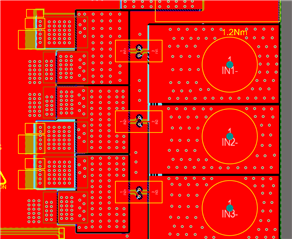Other Parts Discussed in Thread: DRV8320, , DRV8350, DRV8353, DRV8353F, ALLIGATOR
Hi,
I already had a board a few month ago with the same problem, where I used a DRV8320 (e2e.ti.com/.../drv8320r-drv8320r-how-much-rining-is-good-enough) and now I use the DRV8350F for 80V compatibility (more safety margin for the 48VDC Input).
I tought the problem came from a bad layout, too much parasitic inductance, but now the design is way better and the ringing is worse (probably from the MOSFETs, changed from 60V MOSFETs to 80V MOSFETs). It seems like the gate driver overshoot before the Miller Plateau and couples into the output and leads to the overshoot of SHx, but I'm already on the minimum IDRIVE setting of 50mA/100mA, so it seems this gate driver does not work with the MOSFETs I have chosen: BSC040N08NS5ATMA1
I get a significant overshoot at already 12A phase current, only 10V is allowed and I get around 8V. When I go higher, it begins to overshoot the 10V mark. I need to achieve 50A, impossible at the moment.
I'm thinking about using some series resistors for the gate, that could probably solve the problem, but it is not recommended in the datasheet. For example this guy here in this thread uses gate resistors and can easly achieve 100A: https://e2e.ti.com/support/motor-drivers-group/motor-drivers/f/motor-drivers-forum/915569/drv8350-own-hardware-with-drv8350
Here is an overview of the design, I used the “Best Practices for Board Layout of Motor Drivers” PDF and the datasheet for the design to achieve low inductance paths and it seems also all the cross coupling is gone from other MOSFETs, but this ringing is I can not get rid off:



Here is some Overshoot/Ringing from SHA (measured with a GND spring):
And here some Overshoot/Ringing on the GHA (measured with a GND spring):
So, what can I do about this? Are gate series resistors a solution? Shold I change the FETs? Are Snubbers necessary?
Kind Regards,
Sebastian


